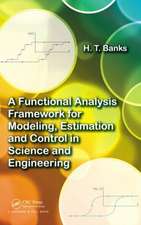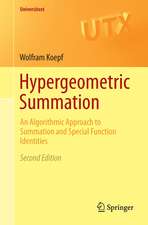Quantum Field Theory I: Basics in Mathematics and Physics: A Bridge between Mathematicians and Physicists
Autor Eberhard Zeidleren Limba Engleză Paperback – 22 aug 2016
| Toate formatele și edițiile | Preț | Express |
|---|---|---|
| Paperback (1) | 1232.39 lei 6-8 săpt. | |
| Springer Berlin, Heidelberg – 22 aug 2016 | 1232.39 lei 6-8 săpt. | |
| Hardback (1) | 2164.34 lei 6-8 săpt. | |
| Springer Berlin, Heidelberg – 13 aug 2009 | 2164.34 lei 6-8 săpt. |
Preț: 1232.39 lei
Preț vechi: 1502.91 lei
-18% Nou
Puncte Express: 1849
Preț estimativ în valută:
235.93€ • 242.64$ • 195.73£
235.93€ • 242.64$ • 195.73£
Carte tipărită la comandă
Livrare economică 17 februarie-03 martie
Preluare comenzi: 021 569.72.76
Specificații
ISBN-13: 9783662500941
ISBN-10: 3662500949
Pagini: 1052
Ilustrații: XXIV, 1052 p.
Dimensiuni: 155 x 235 x 61 mm
Greutate: 1.47 kg
Ediția:Softcover reprint of the original 1st ed. 2006
Editura: Springer Berlin, Heidelberg
Colecția Springer
Locul publicării:Berlin, Heidelberg, Germany
ISBN-10: 3662500949
Pagini: 1052
Ilustrații: XXIV, 1052 p.
Dimensiuni: 155 x 235 x 61 mm
Greutate: 1.47 kg
Ediția:Softcover reprint of the original 1st ed. 2006
Editura: Springer Berlin, Heidelberg
Colecția Springer
Locul publicării:Berlin, Heidelberg, Germany
Descriere
1 Daß ich erkenne, was die Welt im Innersten zusammenh¨ alt. Faust Concepts without intuition are empty, intuition without concepts is blind. Immanuel Kant (1724–1804) The greatest mathematicians like Archimedes, Newton, and Gauss have always been able to combine theory and applications into one. Felix Klein (1849–1925) The present comprehensive introduction to the mathematical and physical aspects of quantum ?eld theory consists of the following six volumes: Volume I: Basics in Mathematics and Physics Volume II: Quantum Electrodynamics Volume III: Gauge Theory Volume IV: Quantum Mathematics Volume V: The Physics of the Standard Model Volume VI: Quantum Gravity and String Theory. Since ancient times, both physicists and mathematicians have tried to und- stand the forces acting in nature. Nowadays we know that there exist four fundamental forces in nature: • Newton’s gravitational force, • Maxwell’s electromagnetic force, • the strong force between elementary particles, and • the weak force between elementary particles (e.g., the force responsible for the radioactive decay of atoms). In the 20th century, physicists established two basic models, namely, • the Standard Model in cosmology based on Einstein’s theory of general relativity, and • the Standard Model in elementary particle physics based on gauge theory. 1 So that I may perceive whatever holds the world together in its inmost folds.
Cuprins
Preface.- Part I. Introduction.- Prologue.- 1. Historical Introduction.- 2. Phenomenology of the Standard Model for Elementary Particles.- 3. The Challenge of Different Scales in Nature.- Part II. Basic Techniques in Mathematics.- 4. Analyticity.- 5. A Glance at Topology.- 6. Many-Particle Systems in Mathematics and Physics.- 7. Rigorous Finite-Dimensional Magic Formulas of Quantum Field Theory.- 8. Rigorous Finite-Dimensional Perturbation Theory.- 9. Fermions and the Calculus for Grassmann Variables.- 10. Infinite-Dimensional Hilbert Spaces.- 11. Distributions and Green's Functions.- 12. Distributions and Physics.- Part III. Heuristic Magic Formulas of Quantum Field Theory.- 13. Basic Strategies in Quantum Field Theory.- 14. The Response Approach.- 15. The Operator Approach.- 16. Peculiarities of Gauge Theories.- 17. A Panorama of the Literature.- Appendix.- Epilogue.- References.- List of Symbols.- Index.
Recenzii
From the reviews:
"Quantum field theory combines relativity, quantum mechanics, and many-particle physics to provide a theoretical basis for the most fundamental understanding of our universe. … it is a fun book for practicing quantum field theorists to browse, and it may be similarly enjoyed by mathematical colleagues. Its ultimate value may lie in encouraging students to enter this challenging interdisciplinary area of mathematics and physics. Summing Up: Recommended. Upper-division undergraduates through faculty." (M. C. Ogilvie, CHOICE, Vol. 44 (9), May, 2007)
"This is the first volume of a six volume book on quantum field theory. … The main object is to explain mathematics for students or researchers in physics how to use them, and to show students and researchers in mathematics how to use them, and to show students and researchers in mathematics how to use mathematics in physics. Translations of different languages used by mathematicians and physicists for the same mathematical objects are also presented." (Akira Asada, Zentralblatt MATH, Vol. 1124 (1), 2008)
"This book on quantum field theory, consisting of over a thousand pages, is the first volume of a projected six-volume series. It alone has seventeen chapters and an appendix … . The appendix covers notation, units, and dimensional analysis. … Quantum field theory is one of the great intellectual edifices in the history of human thought. … This volume differs from other books on quantum field theory in its greater emphasis on the interaction of physics with mathematics. … an impressive work of scholarship." (William G. Faris, SIAM Review, Vol. 50 (2), 2008)
“Volume I is divided in three parts. Part 1 has an introductory nature. … Part II accompanies the reader through a forest of basic techniques in mathematics. … In Part III, Zeidler presents the essential available information on heuristic magic formulas of quantum field theory. … The presentation of the material is clear. … For a scholar aiming to work in quantum field theory … Zeidler can be a reference text. … Mathematicians can find a list of topics who are still waiting rigorous treatments.” (Paolo Maria Mariano, Meccanica, Vol. 46, 2011)
"Quantum field theory combines relativity, quantum mechanics, and many-particle physics to provide a theoretical basis for the most fundamental understanding of our universe. … it is a fun book for practicing quantum field theorists to browse, and it may be similarly enjoyed by mathematical colleagues. Its ultimate value may lie in encouraging students to enter this challenging interdisciplinary area of mathematics and physics. Summing Up: Recommended. Upper-division undergraduates through faculty." (M. C. Ogilvie, CHOICE, Vol. 44 (9), May, 2007)
"This is the first volume of a six volume book on quantum field theory. … The main object is to explain mathematics for students or researchers in physics how to use them, and to show students and researchers in mathematics how to use them, and to show students and researchers in mathematics how to use mathematics in physics. Translations of different languages used by mathematicians and physicists for the same mathematical objects are also presented." (Akira Asada, Zentralblatt MATH, Vol. 1124 (1), 2008)
"This book on quantum field theory, consisting of over a thousand pages, is the first volume of a projected six-volume series. It alone has seventeen chapters and an appendix … . The appendix covers notation, units, and dimensional analysis. … Quantum field theory is one of the great intellectual edifices in the history of human thought. … This volume differs from other books on quantum field theory in its greater emphasis on the interaction of physics with mathematics. … an impressive work of scholarship." (William G. Faris, SIAM Review, Vol. 50 (2), 2008)
“Volume I is divided in three parts. Part 1 has an introductory nature. … Part II accompanies the reader through a forest of basic techniques in mathematics. … In Part III, Zeidler presents the essential available information on heuristic magic formulas of quantum field theory. … The presentation of the material is clear. … For a scholar aiming to work in quantum field theory … Zeidler can be a reference text. … Mathematicians can find a list of topics who are still waiting rigorous treatments.” (Paolo Maria Mariano, Meccanica, Vol. 46, 2011)
Notă biografică
Prof. Dr. Dr. h.c. Eberhard Zeidler works at the Max Planck Institute for Mathematics in the Sciences in Leipzig (Germany). In 1996 he was one of the founding directors of this institute. He is a member of the Academy of Natural Scientists Leopoldina. In 2006 he was awarded the "Alfried Krupp Wissenschaftspreis" of the Alfried Krupp von Bohlen und Halbach-Stiftung.
The author wrote the following books.
(a) E. Zeidler, Nonlinear Functional Analysis and its Applications, Vols. I-IV,
Springer Verlag New York, 1984-1988 (third edition 1998).
(b) E. Zeidler, Applied Functional Analysis, Vol. 1:
Applications to Mathematical Physics, 2nd edition, 1997, Springer Verlag, New York.
(c) E. Zeidler, Applied Functional Analysis, Vol. 2:
Main Principles and Their Applications,
Springer-Verlag, New York, 1995.
(d) E. Zeidler, Oxford Users' Guide to Mathematics, Oxford University Press, 2004
(translated from German).
The author wrote the following books.
(a) E. Zeidler, Nonlinear Functional Analysis and its Applications, Vols. I-IV,
Springer Verlag New York, 1984-1988 (third edition 1998).
(b) E. Zeidler, Applied Functional Analysis, Vol. 1:
Applications to Mathematical Physics, 2nd edition, 1997, Springer Verlag, New York.
(c) E. Zeidler, Applied Functional Analysis, Vol. 2:
Main Principles and Their Applications,
Springer-Verlag, New York, 1995.
(d) E. Zeidler, Oxford Users' Guide to Mathematics, Oxford University Press, 2004
(translated from German).
Textul de pe ultima copertă
This is the first volume of a modern introduction to quantum field theory which addresses both mathematicians and physicists ranging from advanced undergraduate students to professional scientists. The book tries to bridge the existing gap between the different languages used by mathematicians and physicists. For students of mathematics it is shown that detailed knowledge of the physical background helps to motivate the mathematical subjects and to discover interesting interrelationships between quite different mathematical topics. For students of physics, fairly advanced mathematics is presented, which is beyond the usual curriculum in physics. It is the author's goal to present the state of the art of realizing Einstein's dream of a unified theory for the four fundamental forces in the universe (gravitational, electromagnetic, strong, and weak interaction).
From the reviews:
"… Quantum field theory is one of the great intellectual edifices in the history of human thought. … This volume differs from other books on quantum field theory in its greater emphasis on the interaction of physics with mathematics. … an impressive work of scholarship."
(William G. Faris, SIAM Review, Vol. 50 (2), 2008)
"… it is a fun book for practicing quantum field theorists to browse, and it may be similarly enjoyed by mathematical colleagues. Its ultimate value may lie in encouraging students to enter this challenging interdisciplinary area of mathematics and physics. Summing Up: Recommended. Upper-division undergraduates through faculty."
(M. C. Ogilvie, CHOICE, Vol. 44 (9), May, 2007)
From the reviews:
"… Quantum field theory is one of the great intellectual edifices in the history of human thought. … This volume differs from other books on quantum field theory in its greater emphasis on the interaction of physics with mathematics. … an impressive work of scholarship."
(William G. Faris, SIAM Review, Vol. 50 (2), 2008)
"… it is a fun book for practicing quantum field theorists to browse, and it may be similarly enjoyed by mathematical colleagues. Its ultimate value may lie in encouraging students to enter this challenging interdisciplinary area of mathematics and physics. Summing Up: Recommended. Upper-division undergraduates through faculty."
(M. C. Ogilvie, CHOICE, Vol. 44 (9), May, 2007)
Caracteristici
Excellent book for graduate students intending to learn the mathematics required for modern theoretical physics
Includes supplementary material: sn.pub/extras
Includes supplementary material: sn.pub/extras











